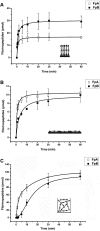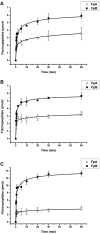Fibrinopeptides A and B release in the process of surface fibrin formation
- PMID: 21106983
- PMCID: PMC3056594
- DOI: 10.1182/blood-2010-08-300301
Fibrinopeptides A and B release in the process of surface fibrin formation
Abstract
Fibrinogen adsorption on a surface results in the modification of its functional characteristics. Our previous studies revealed that fibrinogen adsorbs onto surfaces essentially in 2 different orientations depending on its concentration in the solution: "side-on" at low concentrations and "end-on" at high concentrations. In the present study, we analyzed the thrombin-mediated release of fibrinopeptides A and B (FpA and FpB) from fibrinogen adsorbed in these orientations, as well as from surface-bound fibrinogen-fibrin complexes prepared by converting fibrinogen adsorbed in either orientation into fibrin and subsequently adding fibrinogen. The release of fibrinopeptides from surface-adsorbed fibrinogen and from surface-bound fibrinogen-fibrin complexes differed significantly compared with that from fibrinogen in solution. The release of FpB occurred without the delay (lag phase) characteristic of its release from fibrinogen in solution. The amount of FpB released from end-on adsorbed fibrinogen and from adsorbed fibrinogen-fibrin complexes was much higher than that of FpA. FpB is known as a potent chemoattractant, so its preferential release suggests a physiological purpose in the attraction of cells to the site of injury. The N-terminal portions of fibrin β chains including residues Bβ15-42, which are exposed after cleavage of FpB, have been implicated in many processes, including angiogenesis and inflammation.
Figures





Similar articles
-
Structural basis for sequential cleavage of fibrinopeptides upon fibrin assembly.Biochemistry. 2006 Mar 21;45(11):3588-97. doi: 10.1021/bi0525369. Biochemistry. 2006. PMID: 16533041 Free PMC article.
-
Steady state kinetic parameters for the thrombin-catalyzed conversion of human fibrinogen to fibrin.J Biol Chem. 1983 Aug 10;258(15):9276-82. J Biol Chem. 1983. PMID: 6409903
-
Thrombin-induced fibrinopeptide B release from normal and variant fibrinogens: influence of inhibitors of fibrin polymerization.Biochim Biophys Acta. 1988 May 12;965(2-3):169-75. doi: 10.1016/0304-4165(88)90053-0. Biochim Biophys Acta. 1988. PMID: 3365451
-
Endothelial cell responses to fibrin mediated by FPB cleavage and the amino terminus of the beta chain.Blood Cells. 1993;19(2):291-306; discussion 306-7. Blood Cells. 1993. PMID: 8312565 Review.
-
Novel aspects of fibrin(ogen) fragments during inflammation.Mol Med. 2011 May-Jun;17(5-6):568-73. doi: 10.2119/molmed.2010.00146. Epub 2011 Jan 4. Mol Med. 2011. PMID: 21210072 Free PMC article. Review.
Cited by
-
Plasma proteome changes associated with refractory anemia and refractory anemia with ringed sideroblasts in patients with myelodysplastic syndrome.Proteome Sci. 2013 Apr 8;11(1):14. doi: 10.1186/1477-5956-11-14. Proteome Sci. 2013. PMID: 23566303 Free PMC article.
-
Serum metabolomic profile of hair dye use.Sci Rep. 2023 Mar 7;13(1):3776. doi: 10.1038/s41598-023-30590-3. Sci Rep. 2023. PMID: 36882504 Free PMC article.
-
Tissue factor pathway inhibitor 2 is found in skin and its C-terminal region encodes for antibacterial activity.PLoS One. 2012;7(12):e52772. doi: 10.1371/journal.pone.0052772. Epub 2012 Dec 26. PLoS One. 2012. PMID: 23300768 Free PMC article.
-
Reactive carbonyl compounds (RCCs) cause aggregation and dysfunction of fibrinogen.Protein Cell. 2012 Aug;3(8):627-40. doi: 10.1007/s13238-012-2057-y. Epub 2012 Jul 26. Protein Cell. 2012. PMID: 22836718 Free PMC article.
-
Fungi Fibrinolytic Compound 1 Plays a Core Role in Modulating Fibrinolysis, Altering Plasma Clot Structure, and Promoting Susceptibility to Lysis.Pharmaceutics. 2023 Sep 14;15(9):2320. doi: 10.3390/pharmaceutics15092320. Pharmaceutics. 2023. PMID: 37765289 Free PMC article.
References
-
- Geer CB, Tripathy A, Schoenfisch MH, Lord ST, Gorkun OV. Role of B-b knob-hole interactions in fibrin binding to adsorbed fibrinogen. J Thromb Haemost. 2007;5(12):2344–2351. - PubMed
-
- Geer CB, Rus IA, Lord ST, Schoenfisch MH. Surface-dependent fibrinopeptide A accessibility to thrombin. Acta Biomater. 2007;3(5):663–668. - PubMed
-
- Evans-Nguyen KM, Fuierer RR, Fitchett BD, Tolles LR, Conboy JC, Schoenfisch MH. Changes in adsorbed fibrinogen upon conversion to fibrin. Langmuir. 2006;22(11):5115–5121. - PubMed
-
- Soman P, Rice Z, Siedliecki CA. Measuring the time-dependent functional activity of adsorbed fibrinogen by atomic force microscopy. Langmuir. 2008;24(16):8801–8806. - PubMed
-
- Savage B, Ruggeri ZM. Selective recognition of adhesive sites in surface-bound fibrinogen by glycoprotein IIb-IIIa on nonactivated platelets. J Biol Chem. 1991;266(17):11227–11233. - PubMed
Publication types
MeSH terms
Substances
Grants and funding
LinkOut - more resources
Full Text Sources
Other Literature Sources

